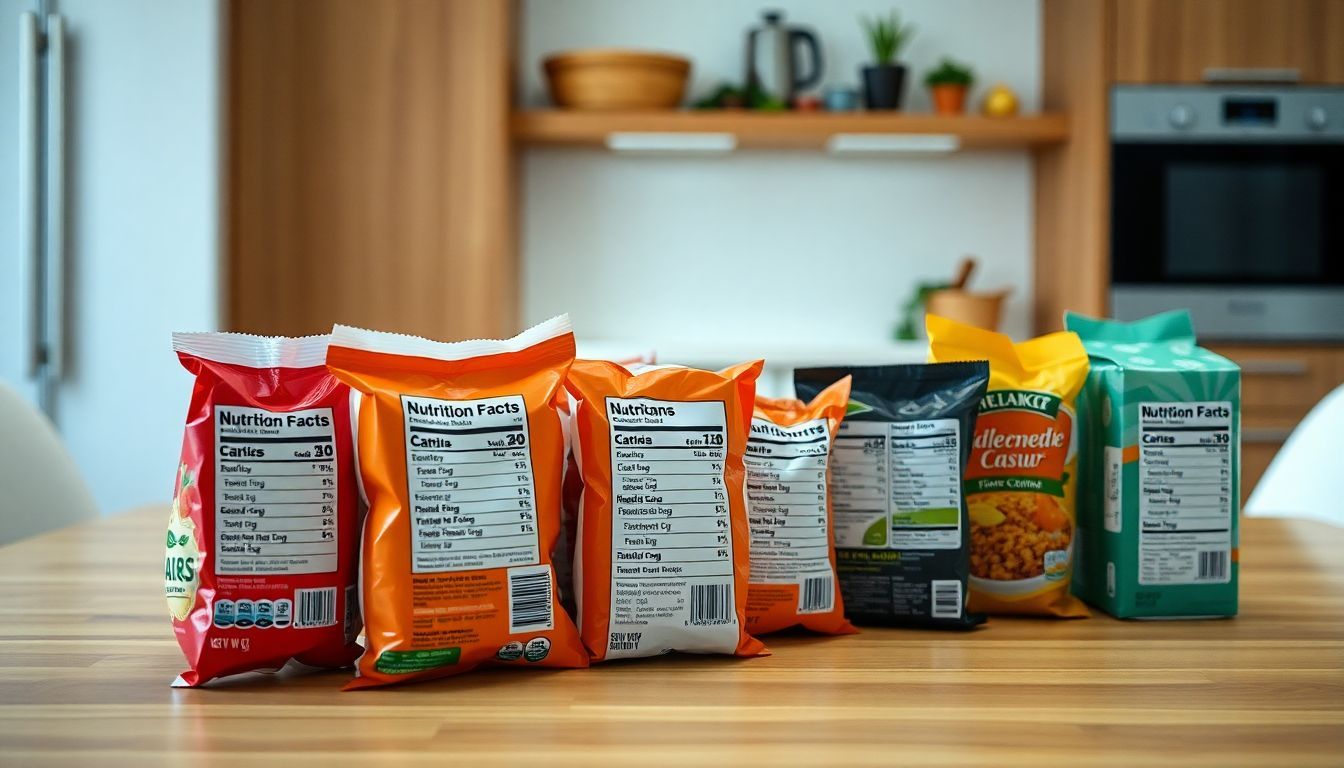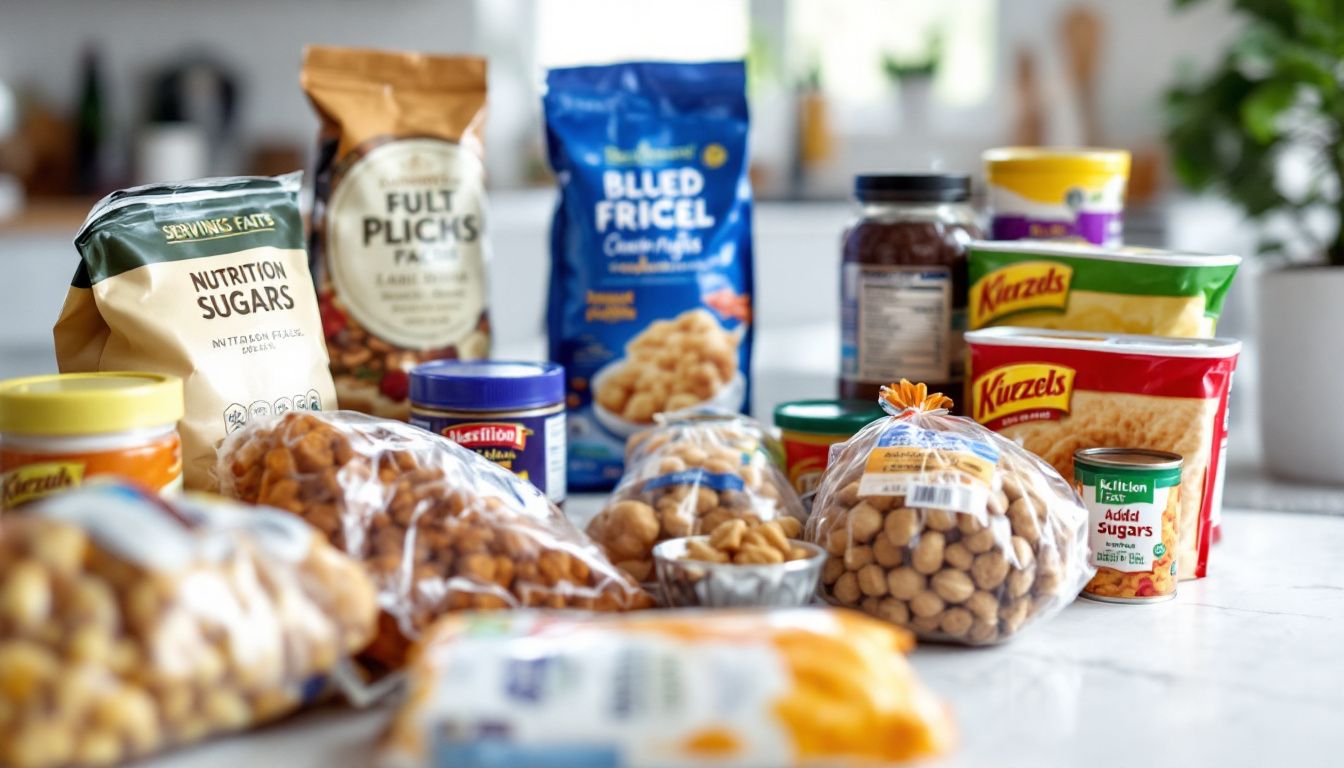Confused by all the tiny print and numbers on food labels? The FDA has updated Nutrition Facts labels to make them easier to read and understand. This blog will explain the key changes, like bigger serving size fonts and added sugars listings, and why they matter for your health.
Thank you for reading this post, don't forget to subscribe!Read on—this could change how you eat!
Key Takeaways
- The FDA updated Nutrition Facts labels to make them clearer. Changes include larger fonts for serving sizes and separate listings for added sugars.
- Serving sizes now reflect how much people actually eat. For example, a 12-ounce soda is one serving instead of multiple servings.
- Added sugars have their own line on the label with grams and % Daily Value (%DV). The daily limit is 50 grams for a 2,000-calorie diet.
- Daily values for nutrients like dietary fiber (28g/day) and sodium were updated based on current health research to support heart health and digestion.
- These changes help consumers track calories, sugar, fiber, and other nutrients easier while promoting smarter food choices for better health.
Key Changes in the New Nutrition Facts Labels
The updated labels are clearer and more user-friendly. They highlight important details to help you make smarter food choices.
Larger font for serving size and servings per container
Serving size and servings per container now appear in a larger, bolder font on nutrition labels. This change helps shoppers quickly find the information they need. It’s especially helpful for older adults who may struggle with small print.
Portion sizes have also been updated to match what people usually eat today. For example, a serving of ice cream might now reflect 2/3 cup instead of 1/2 cup. These adjustments aim to provide more realistic guidance about daily caloric intake and nutrition labeling.
Clearer labels make it easier for everyone to make healthier choices.
Added sugars listed separately
Added sugars now have their own line on the new Nutrition Facts Labels. These are sugars added during food processing or preparation and do not include natural sugars from fruits or milk.
The label shows both the grams of added sugars and their percent Daily Value (%DV). For a 2,000-calorie diet, the daily limit is set at 50 grams.
This change helps consumers track sugar intake more easily. High amounts of added sugars in processed foods can affect heart health, blood pressure management, and weight loss efforts.
With this clear display, making healthier dietary choices becomes simpler while shopping for packaged food products like cereals or snacks—leading to better knowledge about nutrients like sodium on labels.
Updated daily values for nutrients like sodium and dietary fiber
The daily value for dietary fiber is now set at 28 grams per day. This ensures people aim for enough intake to support digestion and heart health. Sodium levels have also been revised based on the latest research, helping manage blood pressure and reducing heart disease risks.
These updates better match modern dietary guidelines for Americans. They reflect recent scientific findings about nutritional needs. Clearer values guide healthier diets while making food packaging labels more useful for consumers seeking a balanced lifestyle….
Benefits of the Nutrition Label Changes
The updated labels make it easier to understand what’s in your food. They help you make smarter choices for better health.
Enhanced clarity for consumers
Calorie counts now stand out with bold fonts. Serving sizes match what people typically eat, making labels easier to understand. Updates like these simplify nutrition information for everyone.
Added sugars are listed on their own, helping shoppers spot unhealthy foods quickly.
These changes aim to guide smarter choices about processed foods and snacks. Clearer labels can improve how people manage daily values of nutrients like sodium or dietary fiber—making healthier diets easier to plan.
Better reflection of modern eating habits…
Better reflection of modern eating habits
The updated nutrition facts labels now align better with how people eat today. Serving sizes reflect what individuals actually consume, not outdated portions. For example, a 12-ounce soda is now considered one serving, matching real habits.
Added sugars are listed clearly to highlight hidden sugars in processed foods. This change helps consumers spot excessive sugar intake from items like flavored yogurts or cereal. Daily values for key nutrients such as dietary fiber and sodium also have been revised based on current health research.
These updates offer more accurate guidance for modern diets while supporting heart disease prevention and blood pressure management goals.
Improved guidance for healthier dietary choices
Serving sizes now match what people actually eat. This change helps consumers make smarter choices without guessing. For example, a bottle of soda that used to count as multiple servings is now labeled as one serving.
The label highlights added sugars with separate listings and % Daily Values. These updates guide you on limiting sugar intake for better health. Understanding these details supports heart disease prevention, cholesterol management, and maintaining cognitive fitness through healthier diets.
Impact on Public Health
The new nutrition labels could help people make smarter food choices—and improve overall health over time.
Potential reduction in overconsumption of sugar
Listing added sugars on nutrition facts labels helps people see how much unnecessary sugar they eat. Health groups, like Harvard Medical School, suggest keeping sugar below 10% of daily calories.
This change can guide better choices and reduce the risk of obesity, diabetes, and heart disease.
Cutting sugar saves lives by improving public health. Excessive intake links to higher rates of these illnesses. Clearer food packaging with updated labels empowers smarter decisions for a healthier lifestyle.
Nationwide efforts may lead to significant benefits over time for everyone.
Greater awareness of nutrient intake
The updated nutrition facts labels help people see what they eat. They now list Vitamin D and potassium, two nutrients many lack, making them a focus for better health. Sodium and dietary fiber levels are also updated to match current science.
These changes make it easier to track daily values and improve overall nutrient awareness.
Added sugars are highlighted separately on the new labels. This helps people limit extra sugar intake and understand how much fits their diets. Seeing clear details about serving sizes also gives better control over calories or saturated fat consumed each day.
These updates guide smarter eating habits for healthier lives.
Strategies to Increase Fruit and Vegetable Intake
Eating more fruits and vegetables helps manage cholesterol, cognitive health, and prevent heart disease. Here are easy ways to include them in your daily diet:
- Add grated carrots or zucchini to dishes like pasta sauce, meatloaf, chili, or stews. This makes meals healthier without changing the taste too much.
- Use fruits at breakfast by putting berries on oatmeal or in yogurt. They add flavor and vitamins.
- Snack on veggie sticks like carrots or celery, or enjoy fruit slices such as apples or oranges.
- Blend smoothies with fruits like bananas and leafy greens such as spinach for a quick nutrient-packed drink.
- Plan meals around fruits and vegetables rather than making them a side dish. For example, make salads, which are the main course, with added protein like chicken or beans.
Remember these tips while exploring other benefits of updated nutrition facts labels!

Challenges and Criticisms
Food companies need time and resources to update labels. Shoppers may also take a while to get used to the changes.
Transition period for food manufacturers
The FDA required food manufacturers to update their Nutrition Facts labels back in 2016. Larger companies had until January 1, 2020, to comply with the changes. Smaller businesses received more time—until July 2018—to meet the new rules.
Shifting packaging designs and printing processes took effort and money for many in the food industry. These changes included making serving sizes easier to read and separating added sugars on labels.
This transition aimed to help consumers make better dietary choices by providing clearer nutrition information upfront.
Consumer adaptation to new label format
Consumers may find the larger font for serving sizes and added sugars helpful. Bigger text makes these details easier to spot on nutrition facts labels. Learning how to read these changes can guide people toward healthier dietary choices.
Some shoppers might feel confused by the new look at first. Clearer layouts, though, aim to simplify nutrition information over time. Updates match modern eating habits, making it easier for everyone to use food packaging as a tool for better health.
Future Directions
New labels may include more details as nutrition science grows. Expect changes to reflect how diets affect health even better.
Ongoing updates based on nutritional science
Updates to nutrition facts labels keep evolving with science. Research linking brain health and heart disease emphasizes the need for clear dietary recommendations. For example, U.S. recommended daily allowances are being reconsidered based on new data about nutrients like soluble fiber, trans fats, and added sugars.
Nutrition rating systems may soon reflect modern needs better. Trends in cognitive fitness suggest labeling could include indicators for mental health benefits of foods such as whole grains or omega-3s.
This ensures healthier food choices align with both physical and cognitive well-being goals.
Potential inclusion of other nutritional indicators
The updated Nutrition Facts Labels may soon include more features. For example, dual-column labels could show nutrition per serving and per container. This would help people understand how much they are consuming at a glance.
Front-of-Package (FOP) systems like Traffic Light labels could also be added. These colors flag high sugars, saturated fats, or sodium levels. Such changes aim to make healthier choices easier while shopping.
Next: Conclusion
Conclusion
These new nutrition facts labels bring knowledge right to your hands. They make it easier to spot calories, serving sizes, and added sugars at a glance. With this clarity, you can make smarter food choices for better health.
Eating well starts with knowing what’s in your food—these updates help us take that simple but important step forward.
For more information on incorporating more fruits and vegetables into your diet, read our guide on common-sense strategies for a healthier diet.
